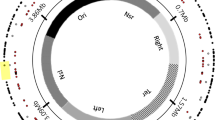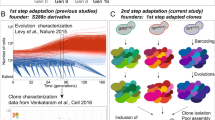Abstract
The relationship between rates of genomic evolution and organismal adaptation remains uncertain, despite considerable interest. The feasibility of obtaining genome sequences from experimentally evolving populations offers the opportunity to investigate this relationship with new precision. Here we sequence genomes sampled through 40,000 generations from a laboratory population of Escherichia coli. Although adaptation decelerated sharply, genomic evolution was nearly constant for 20,000 generations. Such clock-like regularity is usually viewed as the signature of neutral evolution, but several lines of evidence indicate that almost all of these mutations were beneficial. This same population later evolved an elevated mutation rate and accumulated hundreds of additional mutations dominated by a neutral signature. Thus, the coupling between genomic and adaptive evolution is complex and can be counterintuitive even in a constant environment. In particular, beneficial substitutions were surprisingly uniform over time, whereas neutral substitutions were highly variable.
This is a preview of subscription content, access via your institution
Access options
Subscribe to this journal
Receive 51 print issues and online access
$199.00 per year
only $3.90 per issue
Buy this article
- Purchase on Springer Link
- Instant access to full article PDF
Prices may be subject to local taxes which are calculated during checkout


Similar content being viewed by others
Change history
29 October 2009
In the paragraph beginning, 'Several of the long-term populations...', '(599 of 597)' was replaced by '(553 of 599)' on 29 October 2009.
References
Darwin, C. On the Origin of Species by Means of Natural Selection (Murray, 1859)
Fisher, R. A. The Genetical Theory of Natural Selection (Oxford Univ. Press, 1930)
Wright, S. in Proc. 6th Int. Cong. Genet. 1, 356–366 (1932)
Gould, S. J. & Eldredge, N. Punctuated equilibrium: the tempo and mode of evolution reconsidered. Paleobiol. 3, 115–151 (1977)
Eldredge, N. et al. The dynamics of evolutionary stasis. Paleobiol. 31, 133–145 (2005)
Simpson, G. G. The Major Features of Evolution (Columbia Univ. Press, 1953)
Charlesworth, B., Lande, R. & Slatkin, M. A neo-Darwinian commentary on macroevolution. Evolution 36, 474–498 (1982)
Reznick, D. N., Shaw, F. H., Rodd, F. H. & Shaw, R. G. Evaluation of the rate of evolution in natural populations of guppies (Poecilia reticulata). Science 275, 1934–1937 (1997)
Schluter, D. The Ecology of Adaptive Radiations (Oxford Univ. Press, 2000)
Pagel, M., Venditti, C. & Meade, A. Large punctuational contribution of speciation to evolutionary divergence at the molecular level. Science 314, 119–121 (2006)
Blount, Z. D., Borland, C. Z. & Lenski, R. E. Historical contingency and the evolution of a key innovation in an experimental population of Escherichia coli. Proc. Natl Acad. Sci. USA 105, 7899–7906 (2008)
Kimura, M. The Neutral Theory of Molecular Evolution (Cambridge Univ. Press, 1983)
Gillespie, J. H. The Causes of Molecular Evolution (Oxford Univ. Press, 1991)
Ohta, T. The nearly neutral theory of molecular evolution. Annu. Rev. Ecol. Syst. 23, 263–286 (1992)
Elena, S. F. & Lenski, R. E. Evolution experiments with microorganisms: the dynamics and genetic bases of adaptation. Nature Rev. Genet. 4, 457–469 (2003)
Buckling, A., Maclean, C. R., Brockhurst, M. A. & Colegrave, N. The Beagle in a bottle. Nature 457, 824–829 (2009)
Shendure, J. et al. Accurate multiplex polony sequencing of an evolved bacterial genome. Science 309, 1728–1732 (2005)
Fiegna, F., Yu, Y. T., Kadam, S. V. & Velicer, G. J. Evolution of an obligate social cheater to a superior cooperator. Nature 441, 310–314 (2006)
Herring, C. D. et al. Comparative genome sequencing of Escherichia coli allows observation of bacterial evolution on a laboratory timescale. Nature Genet. 38, 1406–1412 (2006)
Hegreness, M. & Kishony, R. Analysis of genetic systems using experimental evolution and whole-genome sequencing. Genome Biol. 8, 201 (2007)
King, M. C. & Wilson, A. C. Evolution at two levels in humans and chimpanzees. Science 188, 107–116 (1975)
Kumar, S. & Hedges, S. B. A molecular timescale for vertebrate evolution. Nature 392, 917–920 (1998)
de Visser, J. A. G. M. & Lenski, R. E. Long-term experimental evolution in Escherichia coli. XI. Rejection of non-transitive interactions as cause of declining rate of adaptation. BMC Evol. Biol. 2, 19 (2002)
Haldane, J. B. S. A mathematical theory of natural and artificial selection. V. Selection and mutation. Proc. Camb. Philos. Soc. 23, 838–844 (1927)
Muller, H. J. Some genetic aspects of sex. Am. Nat. 66, 118–138 (1932)
Gerrish, P. J. & Lenski, R. E. The fate of competing beneficial mutations in an asexual population. Genetica 102/103, 127–144 (1998)
Remold, S. K. & Lenski, R. E. Contribution of individual random mutations to genotype-by-environment interactions in Escherichia coli. Proc. Natl Acad. Sci. USA 98, 11388–11393 (2001)
Paquin, C. E. & Adams, J. Relative fitness can decrease in evolving asexual populations of S. cerevisiae. Nature 306, 368–371 (1983)
Orr, H. A. The population genetics of adaptation: the adaptation of DNA sequences. Evolution 56, 1317–1330 (2002)
Perfeito, L., Fernandes, L., Mota, C. & Gordo, I. Adaptive mutations in bacteria: high rate and small effects. Science 317, 813–815 (2007)
Cooper, T. F., Rozen, D. E. & Lenski, R. E. Parallel changes in gene expression after 20,000 generations of evolution in Escherichia coli. Proc. Natl Acad. Sci. USA 100, 1072–1077 (2003)
Crozat, E., Philippe, N., Lenski, R. E., Geiselmann, J. & Schneider, D. Long-term experimental evolution in Escherichia coli. XII. DNA topology as a key target of selection. Genetics 169, 523–532 (2005)
Sniegowski, P. D., Gerrish, P. J. & Lenski, R. E. Evolution of high mutation rates in experimental populations of E. coli. Nature 387, 703–705 (1997)
Cooper, V. S. & Lenski, R. E. The population genetics of ecological specialization in evolving Escherichia coli populations. Nature 407, 736–739 (2000)
Friedberg, E. C., Walker, G. C. & Siede, W. DNA Repair and Mutagenesis (ASM Press, 1995)
Drake, J. W. A constant rate of spontaneous mutation in DNA-based microbes. Proc. Natl Acad. Sci. USA 88, 7160–7164 (1991)
Ochman, H., Elwyn, S. & Moran, N. A. Calibrating bacterial evolution. Proc. Natl Acad. Sci. USA 96, 12638–12643 (1999)
Lenski, R. E., Rose, M. R., Simpson, S. C. & Tadler, S. C. Long-term experimental evolution in Escherichia coli. I. Adaptation and divergence during 2,000 generations. Am. Nat. 138, 1315–1341 (1991)
Lenski, R. E. Phenotypic and genomic evolution during a 20,000-generation experiment with the bacterium Escherichia coli. Plant Breed. Rev. 24, 225–265 (2004)
Jeong, H. et al. Genome sequences of Escherichia coli B strains REL606 and BL21(DE3). J. Mol. Biol. 10.1016/j.jmb.2009.09.052 (26 September 2009)
Albert, T. J. et al. Mutation discovery in bacterial genomes: metronidazole resistance in Helicobacter pylori. Nature Methods 2, 951–953 (2005)
Woods, R., Schneider, D., Winkworth, C. L., Riley, M. A. & Lenski, R. E. Tests of parallel molecular evolution in a long-term experiment with Escherichia coli. Proc. Natl Acad. Sci. USA 103, 9107–9112 (2006)
Cooper, V. S., Schneider, D., Blot, M. & Lenski, R. E. Mechanisms causing rapid and parallel losses of ribose catabolism in evolving populations of Escherichia coli B. J. Bacteriol. 183, 2834–2841 (2001)
Pelosi, L. et al. Parallel changes in global protein profiles during long-term experimental evolution in Escherichia coli. Genetics 173, 1851–1869 (2006)
Li, H., Ruan, J. & Durbin, R. Mapping short DNA sequencing reads and calling variants using mapping quality scores. Genome Res. 18, 1851–1858 (2008)
Kurtz, S. et al. Versatile and open software for comparing large genomes. Genome Biol. 5, R12 (2004)
Needleman, S. B. & Wunsch, C. D. A general method applicable to the search for similarities in the amino acid sequence of two proteins. J. Mol. Biol. 48, 443–453 (1970)
Stajich, J. E. et al. The Bioperl toolkit: Perl modules for the life sciences. Genome Res. 12, 1611–1618 (2002)
R Development Core Team. R: A language and environment for statistical computing Pages 〈http://www.R-project.org〉. (R Foundation for Statistical Computing, 2007)
Schneider, D., Duperchy, E., Coursange, E., Lenski, R. E. & Blot, M. Long-term experimental evolution in Escherichia coli. IX. Characterization of insertion sequence-mediated mutations and rearrangements. Genetics 156, 477–488 (2000)
Acknowledgements
We thank collaborators in the Lenski and Schneider laboratories for sharing unpublished data; N. Hajela and J. I. Lee for isolation of genomic DNA; C. T. Brown, C. Epstein, C. H. Lee and J. Plotkin for discussion; N. Hajela, L. Ekunwe and S. Simpson for years of technical assistance with the long-term lines; and W. J. Dittmar for assistance with fluctuation tests. We acknowledge support from the DARPA ‘Fun Bio’ Program (to R.E.L.); the US National Science Foundation (to J.E.B. and R.E.L.); the Agence Nationale de la Recherche Programme ‘Génomique Microbienne à Grande Echelle’, Centre National de la Recherche Scientifique, and Université Joseph Fourier (to D.S.); and the 21C Frontier Microbial Genomics and Applications Center Program, Ministry of Education, Science and Technology, Republic of Korea (to J.F.K.).
Author Contributions R.E.L., D.S. and J.F.K. conceived the project and its components. D.S.Y., J.E.B., S.H.Y., H.J., T.K.O. and J.F.K. performed the genome sequencing and confirmatory analyses. D.S. sequenced specific genes in other populations and performed additional molecular procedures. J.E.B. developed code for data analyses and statistical simulations. R.E.L. directs the long-term experiment while J.F.K. directed the genomics work. R.E.L., J.E.B. and J.F.K. analysed the data and wrote the paper. J.E.B., D.S.Y., S.H.Y., R.E.L., D.S. and J.F.K. prepared figures and tables.
Author information
Authors and Affiliations
Corresponding authors
Supplementary information
Supplementary Tables
This file contains Supplementary Tables S1- S4. (PDF 1117 kb)
PowerPoint slides
Rights and permissions
About this article
Cite this article
Barrick, J., Yu, D., Yoon, S. et al. Genome evolution and adaptation in a long-term experiment with Escherichia coli. Nature 461, 1243–1247 (2009). https://doi.org/10.1038/nature08480
Received:
Accepted:
Published:
Issue Date:
DOI: https://doi.org/10.1038/nature08480
This article is cited by
-
Genomics for monitoring and understanding species responses to global climate change
Nature Reviews Genetics (2024)
-
Fast screening method to identify salinity tolerant strains of foliose Ulva species. Low salinity leads to increased organic matter of the biomass
Journal of Applied Phycology (2024)
-
Engineering osmolysis susceptibility in Cupriavidus necator and Escherichia coli for recovery of intracellular products
Microbial Cell Factories (2023)
-
Quantitative systems-based prediction of antimicrobial resistance evolution
npj Systems Biology and Applications (2023)
-
Mutational meltdown in asexual populations doomed to extinction
Journal of Mathematical Biology (2023)
Comments
By submitting a comment you agree to abide by our Terms and Community Guidelines. If you find something abusive or that does not comply with our terms or guidelines please flag it as inappropriate.



